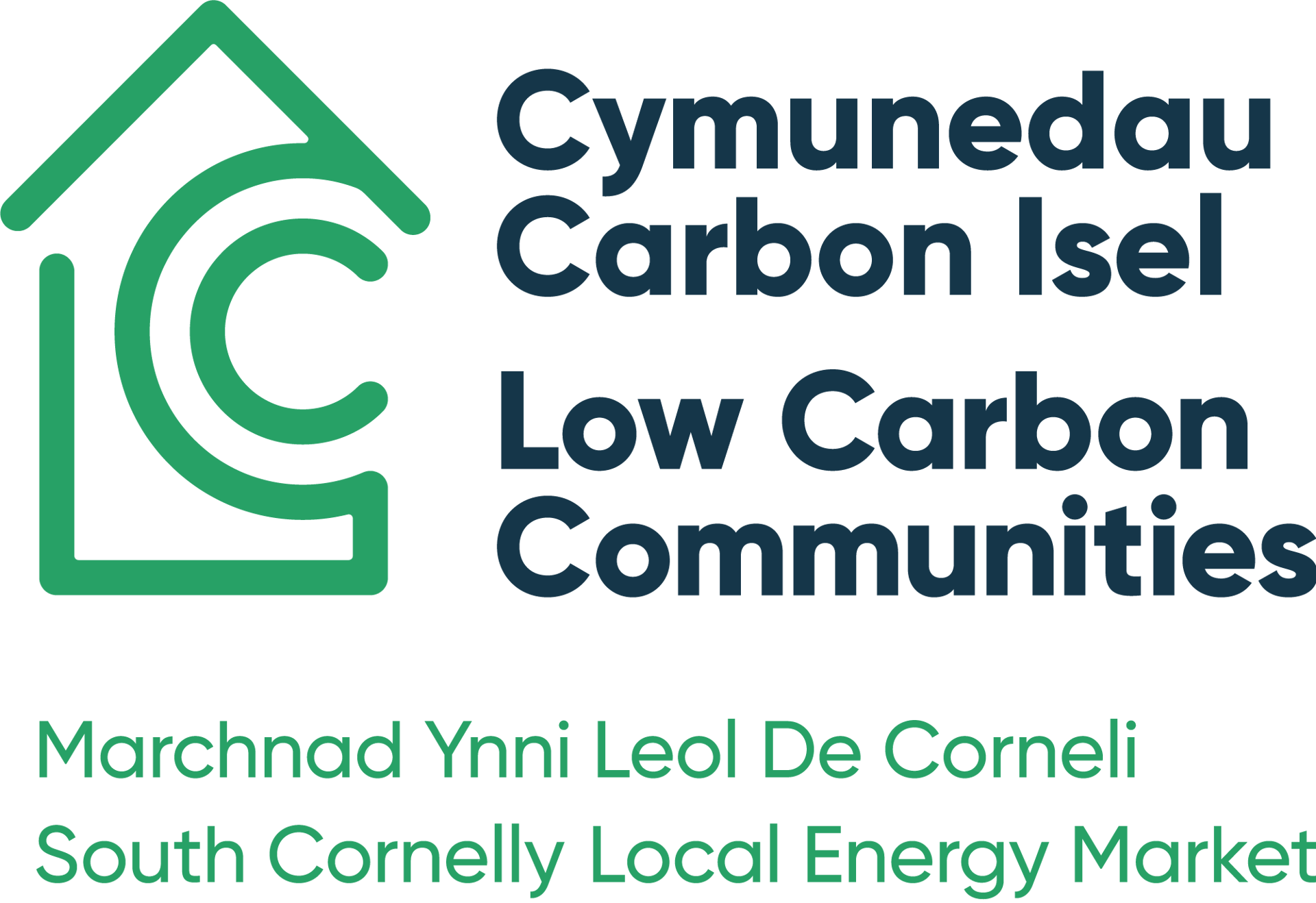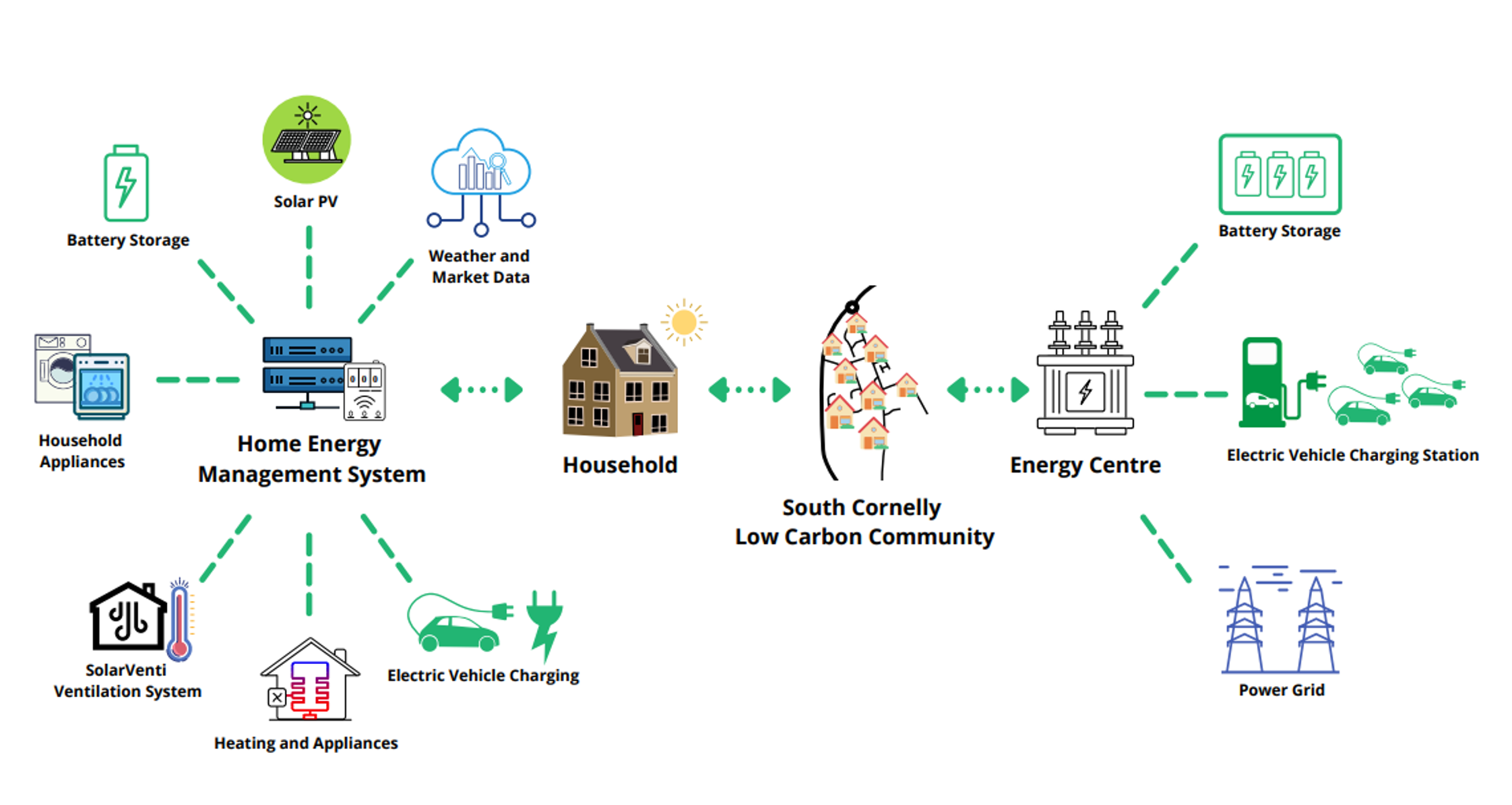South Cornelly Local Energy Market
South Cornelly has been chosen as the site for the first Low Carbon Communities demonstration, and homeowners within the village will shortly be invited to take part in the trial. Its location and structure make it ideal for the following reasons:
- the village is geographically distinct, without any ribbon development
- the village is electrically distinct – served by one substation in the middle of the village (all housing is fed from here)
- the village contains houses with the right orientation for solar energy
- the village is a manageable size for the demonstration project

How will it work?
Solar panels or solar-based ventilation will be fitted to a small number of houses in the chosen village.
In addition, batteries will be installed in some houses and others connected to the local power grid to help balance the supply and demand of power within the community.
The project will investigate how electricity produced can potentially be shared with the other members of the Low Carbon Community.
The partners will use findings from these installations along with digital simulations of the village to help understand how a local energy market can help the community to transition to a low carbon future.
The image shows how a local energy market works, indicating the flow of energy and data between its different elements.

Who can participate
The demonstration project will be trialled in South Cornelly.
In the first instance it will include a small number of mixed households with the following criteria:
- homes with south, east or west facing roofs – to have solar panels installed
- homes that already have solar panels
- some homes with no solar panels to include in the mix with home energy management systems
The demonstration project will be trialled in South Cornelly.
In the first instance it will include a small number of mixed households with the following criteria:
- homes with south, east or west facing roofs – to have solar panels installed
- homes that already have solar panels
- some homes with no solar panels to include in the mix with home energy management systems
Benefits
This is a pioneering demonstration project and by being a part of it, you will be helping to decarbonise South Cornelly in the first instance and if successful, other parts of Wales as well. Benefits will include:
- free installation of equipment
- use of an increased percentage of renewable electricity
- more control over your own electricity supply
How to participate
The demonstration project currently has enough households participating in this phase. We are actively seeking additional funding to extend the project.
If you would be interested in getting involved in the next phase of this project, please send an email to:
Bridgend County Borough Council has been successful in obtaining funding from the Welsh Government through its Whole Business Research Innovation for Decarbonisation (WBRID) based on Small Business Research Initiative principles.
FAQs
Low Carbon Communities is an initiative launched by Bridgend County Borough Council to empower local communities to produce and share renewable electricity amongst participating households whilst helping to fight the climate crisis. This demonstration project will trial a community-based energy market.
Your home may have solar panels and batteries installed to generate and store electricity, which will then be released onto the network when electricity is needed. Your home could also store energy in a battery when the network doesn’t need it (such as midday when it is very sunny or early in the morning when activity is low). All of this will be controlled by software– you won’t have to lift a finger. You will of course be able to continue to use electricity just as you do today. In addition, your home may have a SolarVenti system installed to improve ventilation in the house.
The urgent need to act to address the impact of the climate crisis is familiar to all of us and increasingly, people are asking themselves:
“Yes, but what can we actually do, right here and now, in our own communities, to help?”
The council is working hard to provide an answer with the aim to make the county borough a decarbonised, digitally connected region that works for its inhabitants through its Low Carbon Communities initiatives. This demonstration project will provide vital information as to how a local energy market can work in a local community such as South Cornelly.
If successful, it will be rolled out across the county borough and beyond.
No, there are no fees. Participation is free.
You will be helping to decarbonise South Cornelly in the first instance and if successful, other parts of Wales as well. Benefits will include
- free installation of equipment
- use of an increased percentage of renewable energy
- more control over your own electricity supply
- Monthly health check
- Access to helpdesk support
You don’t need to do anything differently as we want you to live your lives as normal. Your experiences and views are important and we will contact you for feedback.
No, not during the demonstration.
Approximately one week for solar panels and half day for SolarVenti. There will also be an initial pre-selection survey for SolarVenti systems that takes about 2 hours.
We will use professional installers who will keep disruption to a minimum.
No.
The Low Carbon Communities consortium comprised of Nuvision Wales, Passiv UK, Challoch Energy, and Bridgend County Borough Council. It will not be shared with third parties. Nor will your personal data.
An essential element of this project is to publicise what we are doing to share the learnings and developments. From time to time, we may ask for your participation in interviews, photographs and videos. We will not disclose any of your personal information or images of you without your permission.
Yes, only a few of the homes will have solar panels on their roofs while others will be connected to the overall network.
Solar PV/ Batteries
The technologies installed will be owned by the Low Carbon Communities consortium.
No.
The installer.
No.
Yes, this will be provided to you.
Yes, we can integrate your solar into the LEM.
If the trial does not move forward to the next phase, ownership of the equipment will be transferred (free of charge) to homeowners.
Solar Ventilation
The use of air from the natural environment for ventilation within a home through use of solar energy.
A patented system for extracting, warming and drying air from the natural environment for use within a home for ventilation purposes.
The main element of the system is a panel that looks very similar to a Photo Voltaic (PV) panel. Dimensions are circa 2000 *1000* 60mm deep.
The SolaVenti system will improve ventilation in the home and reduce energy bills.
Yes and full instructions for making changes to the parameters such as fan speed will be provided and demonstrated to the home owner.
No as adjustments are possible to minimise any noise.
The instrument installed for monitoring will provide information and will be given to the homeowner.
Yes but this will depend on the system installed, property type etc.
Yes and the interpretation of the findings will be discussed with the homeowners. No data will be put into the public domain.
Low Carbon Communities partners:
Challoch Energy is a low carbon energy consultancy assisting organisations in responding to energy and environmental challenges. Challoch will be overseeing the installation of the solar panels and batteries to understand how a local energy market could be used to help a community share the benefits of locally produced renewable electricity.
Nuvision, a south Wales based company will be installing an innovative solar ventilation system within homes along with an air quality monitoring system. After first undertaking pre-installation surveys by their professional field staff, the equipment will be fitted by their trained installers. Throughout the trial period, brief interviews will be carried out with homeowners to gain their feedback on the system and to advise on improvements where possible.
Passiv is a specialist in low-carbon technology and has developed unique capabilities in home energy management. As part of this project, Passiv will be building detailed simulations of the village electricity system to understand how a local energy market can be used to help the community engage with the wider energy system

